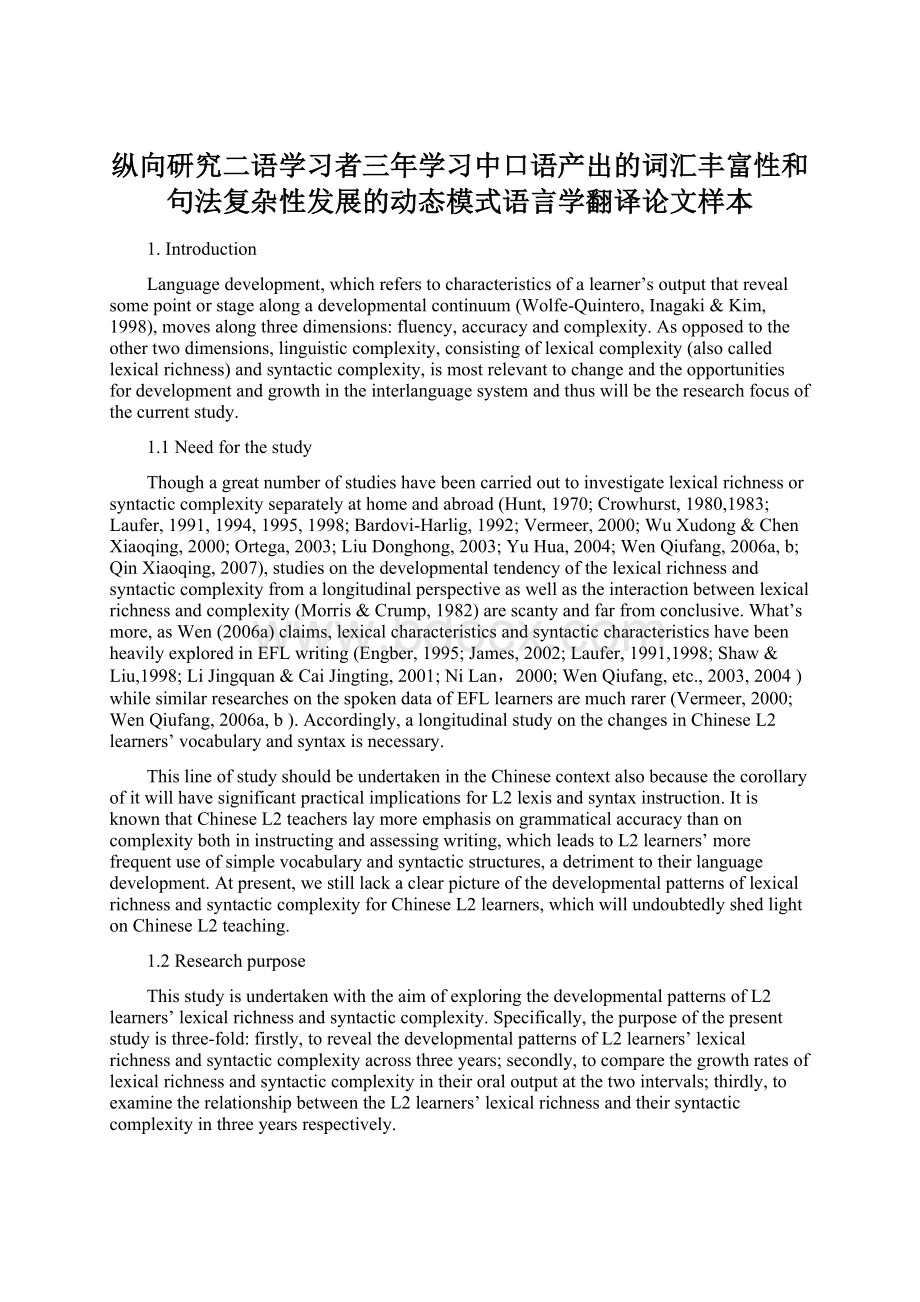纵向研究二语学习者三年学习中口语产出的词汇丰富性和句法复杂性发展的动态模式语言学翻译论文样本文档格式.docx
《纵向研究二语学习者三年学习中口语产出的词汇丰富性和句法复杂性发展的动态模式语言学翻译论文样本文档格式.docx》由会员分享,可在线阅读,更多相关《纵向研究二语学习者三年学习中口语产出的词汇丰富性和句法复杂性发展的动态模式语言学翻译论文样本文档格式.docx(21页珍藏版)》请在冰豆网上搜索。

Thoughagreatnumberofstudieshavebeencarriedouttoinvestigatelexicalrichnessorsyntacticcomplexityseparatelyathomeandabroad(Hunt,1970;
Crowhurst,1980,1983;
Laufer,1991,1994,1995,1998;
Bardovi-Harlig,1992;
Vermeer,2000;
WuXudong&
ChenXiaoqing,2000;
Ortega,2003;
LiuDonghong,2003;
YuHua,2004;
WenQiufang,2006a,b;
QinXiaoqing,2007),studiesonthedevelopmentaltendencyofthelexicalrichnessandsyntacticcomplexityfromalongitudinalperspectiveaswellastheinteractionbetweenlexicalrichnessandcomplexity(Morris&
Crump,1982)arescantyandfarfromconclusive.What’smore,asWen(2006a)claims,lexicalcharacteristicsandsyntacticcharacteristicshavebeenheavilyexploredinEFLwriting(Engber,1995;
James,2002;
Laufer,1991,1998;
Shaw&
Liu,1998;
LiJingquan&
CaiJingting,2001;
NiLan,2000;
WenQiufang,etc.,2003,2004)whilesimilarresearchesonthespokendataofEFLlearnersaremuchrarer(Vermeer,2000;
WenQiufang,2006a,b).Accordingly,alongitudinalstudyonthechangesinChineseL2learners’vocabularyandsyntaxisnecessary.
ThislineofstudyshouldbeundertakenintheChinesecontextalsobecausethecorollaryofitwillhavesignificantpracticalimplicationsforL2lexisandsyntaxinstruction.ItisknownthatChineseL2teacherslaymoreemphasisongrammaticalaccuracythanoncomplexitybothininstructingandassessingwriting,whichleadstoL2learners’morefrequentuseofsimplevocabularyandsyntacticstructures,adetrimenttotheirlanguagedevelopment.Atpresent,westilllackaclearpictureofthedevelopmentalpatternsoflexicalrichnessandsyntacticcomplexityforChineseL2learners,whichwillundoubtedlyshedlightonChineseL2teaching.
1.2Researchpurpose
ThisstudyisundertakenwiththeaimofexploringthedevelopmentalpatternsofL2learners’lexicalrichnessandsyntacticcomplexity.Specifically,thepurposeofthepresentstudyisthree-fold:
firstly,torevealthedevelopmentalpatternsofL2learners’lexicalrichnessandsyntacticcomplexityacrossthreeyears;
secondly,tocomparethegrowthratesoflexicalrichnessandsyntacticcomplexityintheiroraloutputatthetwointervals;
thirdly,toexaminetherelationshipbetweentheL2learners’lexicalrichnessandtheirsyntacticcomplexityinthreeyearsrespectively.
2.Literaturereview
InthefieldofSecondLanguageAcquisition(SLA)research,languagecompetencecanbestudiedfromdifferentaspects.Asforproductivity,languagecompetencecanmovealongtwodimensions:
lexicalcomplexity(alsocalledlexicalrichness)andsyntacticcomplexity.Additionally,accordingtoWolfe-Quinteroetal.(1998),complexitymeansthatawidevarietyorawiderangeofbothbasicandsophisticatedstructuresandwordsareavailableandcanbeaccessedquickly.InWolfe-Quintero’sdefinition,thefirsthalfreferstosyntacticcomplexitywhilethelatterreferstolexicalrichness.Thischapterconsistsofthreeparts.Thefirstpartfocusesonlexicalrichness,thesecondpartonsyntacticcomplexityandthethirdpartonproblemsinthepreviousstudies.
2.1Lexicalrichness
Manyscholars(Linnarud,1986;
Nihanani,1981;
Hyltenstam,1988;
Engber,1995)havedonesomeresearchesonlexicalrichness.Laufer(1994)definedlexicalrichnessasconsistingoflexicalvariance,lexicaldensity,lexicalsophisticationandlexicaloriginality.
Severaltypesofratiomeasureshavebeenutilizedinresearchonsecondlanguagelexicaldevelopmentinwriting.Lexicalvariancewasmeasuredbyatype/tokenratio(Laufer,1991).Lexicaldensitywascalculatedbydividingthenumberoftypesbythenumberoflexicaltokens(Engber,1995).Lexicalsophisticationwasmeasuredbytheratiooftheadvancedlexemestothetotalnumberofwords,asdoneinEngber(1995).Lexicaloriginalitywascalculatedbydividingthenumberoftokensuniquetoawriterbythetotalnumberoftokens(Linnarud,1986).
Amongthesemeasures,lexicalvariationmeasureandlexicalsophisticationmeasurearemostfrequentlyused.Wolfe-Quinteroetal.(1998)notedthatlexicalcomplexitywasmanifestinwritingprimarilyintermsoftherange(lexicalvariation)andsize(lexicalsophistication)ofasecondlanguagewriter’sproductivevocabulary.Theyconcludedthatmeasuresoflexicalvariationandsophisticationappearedtobestrelatetosecondlanguagedevelopment.Althoughlexicalvariationandsophisticationmeasureshavenotbeensystematicallyinvestigatedinmanystudiesorformanyprogramlevels,theydidofferpromiseasindicatorsoflanguagedevelopment.Thisthesisaimstoreviewlexicalvarianceandlexicalsophisticationastwoindicatorsoflexicalrichness.
2.1.1Lexicalvariance
InLinnarud’s(1986)study,lexicalvariancewasdefinedasthetotalnumberofdifferentlexicalitemsorwordtypesdividedbythetotalnumberoflexicalwordsinatext.Thesubjectsfellintotwogroups:
theL2learnergroup-17-year-oldSwedishlearners(L2highschooljuniors),andthenativespeakergroupatthesameschoollevel.Theywereaskedtowriteapicturedescriptionessayin40minutes.Linnarud(1986)comparedthecompositionsinlexicalvariancebetweenthetwogroups.ShefoundacleardifferenceinlexicalvariancebetweentheL2learnersandthenativespeakers:
theL2learnerslackedlexicalvariation.ShealsohadeachcompositionholisticallyscoredinordertoexaminewhethertherewasasignificantrelationshipbetweenlexicalvarianceandL2writingquality.Asaresult,norelationshipwasfoundbetweentheholisticscoresandthismeasureforboththeL2learnergroupandthenativespeakergroup.
InNihanani’s(1981)study,lexicalvariancewasdefinedasthetotalnumberofdifferentlexicalitemsdividedbythetotalnumberoflexicalwordsinatext.Nihanani(1981)collectedthetake-homeessayswrittenbyL2universitystudents.Shecountedeachlexicalvariancescorebasedonthegivendefinitionandhadeachessayholisticallyscored.ThesameresultasLinnarud’s(1986)wasfound:
therewasnosignificantrelationshipbetweentheholisticscoresandlexicalvariance.
InHyltenstam’s(1988)study,theL2learnersweresecondyearhighschoolstudents.Theywereaskedtowriteasummaryandresponsetoa20-minutefilmwithouttimelimit.UnlikeNihanani(1981)andLinnarud(1986),Hyltenstam(1988)controlledforthetextlengthwhencalculatingalexicalvariancescore.However,Hyltenstam(1988)foundasimilarresult:
therewasnorelationshipbetweenlexicalvarianceandL2writingquality.
InEngber(1995)andLinnarud(1986),lexicalvariancewasdefinedinthesameway.However,Engber(1995)foundadifferentresult.Inherstudy,theL2learnerswerestudentsatanintermediatetohigh-intermediatelevelsoflanguageproficiency.Theywererequiredtowriteonthesametopicwithin35minutes.Thetopicwaschosenfromapooloftopicsthathadbeenproventobesuitableforelicitingresponsesatdifferentlevels.Sheusedaholisticscoringschemetomeasurethequalityofeachcomposition.Thequalityscoreswerethencomparedwiththequantitativemeasuresoflexicalvariance.Hercalculationofalexicalvariancescorewasunique:
shedividedeveryessayinto126-wordsegments,eachsegmentwastreatedasaseparateunitandanaveragelexicalvariancescorefortheessaywasthencalculatedastheratioofthesumofthedifferentwordspersegmenttothesumofthetotalnumberoflexicalwordspersegment.Shecalculatedthemeasureoflexicalvariancefirstwithlexicalerrorsincludedandthenwitherrorseliminated,andfoundmoderatelyhigh,statisticallysignificantcorrelationsbetweenthewritingqualityandeitherofbothmeasures.Acomparisonofthemeansforthesetwomeasuresshowedahighercorrelationforlexicalvariationwithouterror(r=0.57)thanforthatwitherror(r=0.45).
Wolfe-Quinteroetal.(1998,p.109)heldthatthismeasurecapturedtheintuitionthatsecondlanguagewritersatahigherproficiencylevelwillcommandalargervocabularysizeandwillbeabletousesignificantlymorelexicalwordtypesthanwritersatalowerproficiencylevel.
2.1.2Lexicalsophistication
Anumberofresearchers(Laufer,1991;
Linnarud,1986;
LiuDonghong,2003)usedlexicalsophisticationtomeasurehowmanylowfrequencyoradvancedwordswereusedinatext.
Linnarud(1986)definedlexicalsophisticationasthenumberofsophisticatedlexicalwordsdividedbythetotalnumberoflexicalwordsinatextandsophisticatedlexicalwordsasthoseEnglishwordsthatweregenerallyintroducedatgrade9andaboveintheSwedisheducationalsystem.Hefoundthatnativelanguagewritersusedsignificantlymoresophisticatedwordsthansecondlanguagewriters(0.25versus0.21),butfoundalowcorrelationbetweentheratioofsophisticatedwordsandtheholisticratingsofthecompositions.Thelowcorrelationmaybeunderstandable,sincethestudentswereatalowerlanguageproficiencylevelandhadnocommandofalargeactivevocabulary.
Laufer(1994)definedlexicalsophisticationastheratioofthetotalnumberofsophisticatedwordtypesdividedbythe